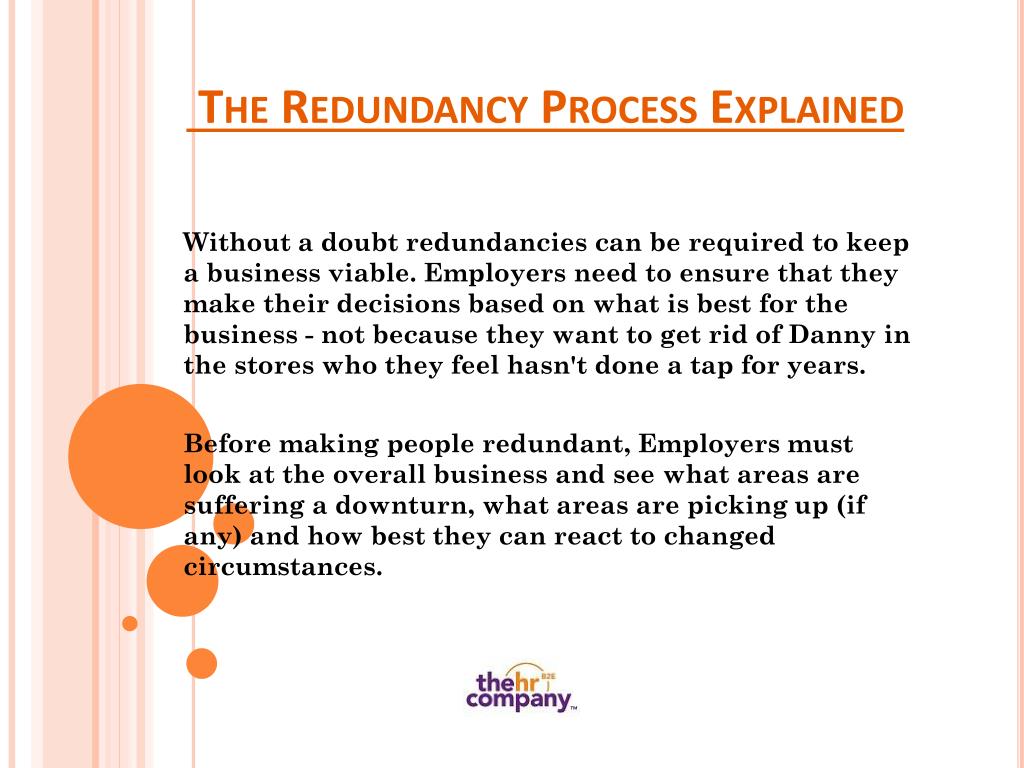Small Business Closing Employee Rights UK: What You Need to Know About Redundancy
Small Business Closing Employee Rights UK: What You Need to Know About Redundancy
Blog Article
Discovering the Operational Characteristics of Company Redundancy and Its Long-Term Sustainability

Redundancy Methods for Business Connection
In order to ensure undisturbed procedures, businesses should apply effective redundancy approaches for organization connection. Redundancy in this context refers to the replication of critical components or functions within a system to reduce the influence of potential failings. By incorporating redundancy techniques, companies can improve their strength against disturbances brought on by different factors such as natural calamities, devices failures, or cyber-attacks.
One usual redundancy technique is the implementation of backup systems and information storage services. This involves producing duplicates of vital data and systems that can be triggered in situation of a key system failing. Furthermore, organizations can develop redundant communication networks and source of power to preserve connectivity and procedures during unpredicted events.
Additionally, cross-training staff members to do several functions within the business can act as an important redundancy method. If key employees are unavailable due to disease or other reasons, this guarantees that crucial tasks can still be brought out also. Overall, efficient redundancy approaches are crucial for organizations to support functional connection and minimize the influence of prospective disruptions.
Influence of Redundancy on Organizational Resilience
Offered the essential role redundancy techniques play in making certain business continuity, discovering the impact of redundancy on organizational durability ends up being vital for recognizing the holistic functional dynamics of a business. Redundancy, when strategically implemented, can considerably add to improving an organization's durability in the face of unexpected challenges.
Moreover, redundancy can reinforce worker spirits and confidence, recognizing that there are contingency strategies in position to resolve unforeseen conditions. This feeling of protection can bring about enhanced performance and an extra favorable workplace. In addition, redundancy can promote development and creative thinking within an organization as workers feel equipped to take calculated risks, understanding that there is a safety net to support them in case of failing. In general, the influence of redundancy on organizational durability is profound, shaping the long-term sustainability and success of a company.
Balancing Efficiency and Versatility in Redundancy
Accomplishing a harmonious stability in between operational effectiveness and flexible flexibility is an essential obstacle in the tactical implementation of redundancy within organizations. Also much flexibility without a strong functional structure can result in ineffectiveness and disparity.
To balance performance and flexibility in redundancy planning, organizations must very carefully evaluate their operational requirements, market characteristics, and calculated goals. Ultimately, locating the right equilibrium in between performance and versatility is essential for constructing a lasting and resistant organization in the face of unpredictability.
Long-Term Sustainability With Redundancy Planning
To ensure enduring practicality and security, companies must strategically straighten their redundancy preparation with long-term sustainability objectives, thereby balancing operational efficiency with flexible versatility. Business should check out redundancy not as a responsive option to prompt troubles but as a positive strategy for long-lasting success.

Proactive Steps for Sustainable Company Workflow
Exactly how can firms proactively boost their functional sustainability for long-term success? Implementing proactive steps is crucial for business intending to guarantee sustainable operations.
Furthermore, fostering a society of constant browse around this site improvement and knowing within the organization can enhance versatility to transforming market conditions and customer demands. Urging worker involvement in decision-making processes and providing chances for expert development can increase morale, performance, and general performance. Establishing clear objectives, keeping an eye on vital performance indicators, and frequently reviewing progression are essential parts of aggressive sustainability administration.
Teaming up with vendors, customers, and other stakeholders to advertise sustainable methods throughout the supply chain can create a surge result of positive impact - redundancy pay pop over here if company goes bust. By taking positive actions towards operational sustainability, firms can construct durability, drive technology, and secure their lasting success in an ever-evolving organization landscape
Verdict

In the realm of organizational monitoring, the tactical release of business redundancy stands as an essential yet detailed method that demands a delicate balance between functional efficiency and long-term stability. By dissecting the operational characteristics that underpin firm redundancy and reviewing its wider implications for business durability and versatility, a nuanced understanding of exactly how redundancy strategies can form the future trajectory of a company begins to unravel.Given the important duty redundancy methods play in ensuring business continuity, checking out the effect of redundancy on organizational strength comes to be vital for understanding the holistic functional characteristics of a firm. On the whole, the influence of redundancy on organizational resilience is extensive, shaping the long-term sustainability and success of a company.
In final thought, understanding the functional characteristics of company redundancy is vital like it for making sure long-term sustainability.
Report this page